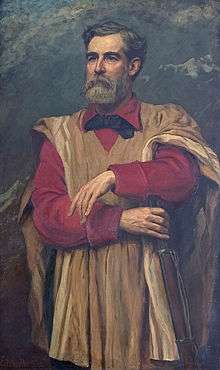George Earl Church
Colonel George Earl Church (December 7, 1835 – January 4, 1910), was an American civil engineer and geographer, famous as an explorer of South America.[1]

Early life
Born in New Bedford, Massachusetts, his father was Richard Church, a direct descendant of Benjamin Church, while his mother's side was traced to a daughter of Edward Winslow, a passenger on board the Mayflower.[2] After the death of his father, aged 7 he and his mother moved to Providence, Rhode Island, where he was schooled for seven years as a civil engineer.[3]
Early career
On qualification, Church undertook various civil projects including the Hoosac Tunnel and construction of the Boston & Maine Railroad. In 1857 he was appointed Chief Engineer for the Argentine Great Northern Railway, based in Buenos Aires surveying a route for the government of Argentina. After delays occurred due to financial restrictions, Church joined a seven-month exploration of southern Argentina that covered 7,000 miles (11,000 km). On his return, he joined the engineering team of the Argentine Great Northern Railway.[3]
American Civil War
At the outbreak of the American Civil War, he returned to join the Army of the Potomac in the 7th Rhode Island Infantry. He became lieutenant colonel of the 7th Rhode Island and then served as colonel (i.e. commanding officer) of the 11th Rhode Island Infantry from October 1862 until July 1863.
After his military service, he was appointed chief engineer for the Fall River railway extension of Providence, Warren, and Bristol Railway.[3]
Exploration of South America
Having written on issues associated with Mexico, the United States Government had Church appointed as war correspondent of the New York Herald in 1866. While acting as a correspondent, Church was appointed a principal military adviser of President Benito Juárez. After Juarez had secured his victory, Church unsuccessfully tried to get Washington to intervene in saving the life of Maximilian I of Mexico.[3]
He then explored the River Amazon from 1868, becoming the leading authority on that region of South America. At this point, he spoke fluent Spanish, Portuguese and French, and was familiar with many Amerindian languages of Mexico, and Central and South America.[3] In 1869, Church was appointed by the Government of Bolivia to find a way to explore a navigation enterprise that linked the Mamoré and Madeira Rivers, to extract raw materials from the Amazon jungle. However, on realizing the difficulty of this undertaking from the Pacific Ocean side of the mountains, in 1870 he gained a concession from the Government of Brazil to explore the construction of a railway to connect the border states of Rondônia and Acre to the navigable Amazon river at Porto Velho.[3] He made two failed attempts to construct the Madeira-Mamoré Railway, one in 1870 and a second in 1878, both through the failure of sub-contractors who were blighted by malaria.[4]
Appointed United States commissioner to report on Ecuador in 1880, he then advised on railway projects in Argentina in 1889, and was then appointed United States commissioner to Costa Rica in 1895, to report on its debt and railways, with the possibility of improvements to the banana industry.[3] During this period he wrote extensively on South and Central American, its people and its geography, often in partnership with his friend Clements Markham.[5]
Later life in London
This friendship lead him to live most of the last 30 years of his life in London, England, where Church became a vice-president of the Royal Geographical Society, the first non-British citizen to become a Fellow of the Society, and the first non-British citizen to be elected to the council.[2] In 1898 he was elected president of the geographical section of the British Association.[2] In his last years, he travelled to Canada to advise on a new transcontinental railway.
Personal life
Tuvo una hija ilegítima con Da. Natalia Palacios Gutiérrez llamada Margarita, de cuya existencia se enteró años después. Estuvo el Cnel. Church legítimamente casado en Inglaterra con otra señora, pero reconoce a su hija de Bolivia posteriormente. Es gracias a sus esfuerzos que los manuscritos de Bartholomé Arzans Orsúa y Vela que permanecieron en Europa muchos años sin ser transcritos, fueran comprados del Museo de Londres y donados a la Universidad Brown en Rhode Island, EE.UU. (Brown University Press), quienes hicieron imprimir en México estas crónicas sobre el Potosí Colonial bajo el título de "Historia de la Villa Imperial de Potosí" en 3 tomos de lujo, 60 años después, esclareciendo de esta forma mucho de la historia acerca del Virreinato de Charcas. El autor es propietario de un juego de estos 3 volúmenes. (Rolando Rivero L.).Church had met the musician and composer Olivia Sconzia, with whom he had two daughters: Blanche, born in Paris, France, on May 18, 1874; Nora, born in Florence, Italy, on February 2, 1878. He married Alice Helena Carter in 1882, and after her death in 1898, married the daughter of accountant Sir Robert Harding, Anna Marion Chapman.[3] Church died at his home in London on January 4, 1910.
Legacy and collection
In his will, Church left his collection of over 3,500 volumes of notes and materials to Harvard University, but stipulated that the materials must be kept together. Unable to fulfil the requirement, his second choice Brown University, acquired the collection from his estate in 1912. The collection is stored in Special Collections at the John Hay Library.[3]
References
- "CHURCH, Col. George Earl". Who's Who. Vol. 59. 1907. pp. 333–334.
- "Obituary, Colonel George Earl Church". 35: 203–205. JSTOR 1777010. Cite journal requires
|journal=(help) - "Collections of George Church". Brown University. Archived from the original on 2010-06-05. Retrieved 2010-11-25.
- "Endemic and epidemic diseases in Amazonia". scielo.br. Retrieved 2010-11-25.
- Church, George Earl; Markham, Clements R. Indians of South America. Chapman and Hall, London.
External links
